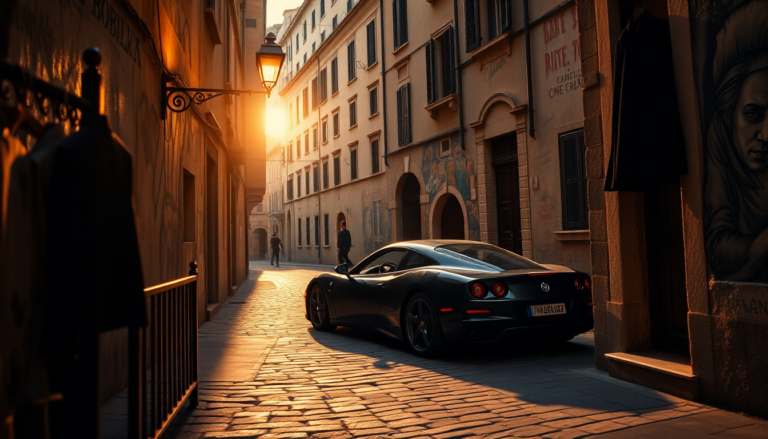Argomenti trattati
The cinematic world of Diabolik: Ginko at the attack not only captivates audiences with its thrilling plot but also immerses them in the atmospheric backdrop of Italian cities. This film, a sequel directed by the Manetti Bros, showcases iconic locations that enhance the narrative, creating a unique blend of crime and elegance. As viewers follow the story of the master thief Diabolik, played by Giacomo Gianniotti, and his relentless pursuer, Inspector Ginko, portrayed by Valerio Mastandrea, they are treated to a visual feast that highlights the beauty and mystery of Italy.
The significance of location in Diabolik
In Diabolik: Ginko at the attack, locations are more than mere settings; they are integral to the storytelling. Each place is carefully selected to reflect the film’s noir style, characterized by shadows and light, urban landscapes brimming with secrets, and intriguing corners that evoke curiosity. The film captures the essence of the original comic series, blending realistic and fantastical elements to create an immersive experience. Each location serves to deepen the viewer’s understanding of the characters and their motivations, making the film a visual and narrative treat.
Bologna as the fictional Clerville
Bologna transforms into the fictional city of Clerville, where action-packed chases and confrontations unfold. The film makes use of various locales, including via Marconi, piazza dei Martiri, and via Don Minzoni, crafting a dynamic urban atmosphere. Aerial shots taken with drones reveal the striking landscape of the Nuova Porrettana, which connects the outskirts of Borgonuovo to the heart of Sasso Marconi, showcasing Inspector Ginko’s relentless pursuit as he navigates the city in his Citroën Pallas.
The European influences in Clerville
The depiction of Clerville draws inspiration from real European cities, with notable influences from Milan and Genoa. The narrow streets, intricate bridges, and vibrant squares play pivotal roles in the thrilling chase sequences and the cunning heists orchestrated by Diabolik. A standout location is Diabolik’s secret villa, nestled within the mountains, which serves as a perfect hideout for the clever thief. This site features advanced technology and hidden passages, reflecting Diabolik’s resourcefulness.
Contrasting settings: Bologna and Milan
The seamless interplay between the recreated Clerville in Bologna and the iconic scenes shot in Milan creates a visually striking contrast. Milan contributes key locations such as via Larga and piazza della Scala, which serve as crucial arteries of Clerville’s narrative. Interestingly, to maintain the film’s classic atmosphere, the famous “Dito” by Maurizio Cattelan was either absent or digitally removed from certain shots in Piazza Affari. Additionally, the façade of the Hotel Excelsior, where Eva Kant resides, is vividly showcased in piazza Giuseppe Missori, enhancing the film’s luxurious aesthetic.
Trieste and beyond
Trieste also features prominently, with scenes filmed at the renowned Caffè San Marco and in corso Italia and piazza della Borsa. Here, the film captures exhilarating car chases between Inspector Ginko and Diabolik’s iconic Jaguar E-Type. The city’s port adds a layer of intrigue, as it serves as the backdrop for secret exchanges and daring escapes, with shipping containers and bustling docks amplifying the suspense. Other beautiful locales in Friuli Venezia Giulia, such as Muggia and the Monte San Michele in Gorizia, further enrich the film’s visual narrative.
Coastal landscapes and the noir aesthetic
The film also incorporates stunning coastal views, framing some of the key scenes that traverse various Italian realities, culminating in a captivating portrayal of the enigmatic world of Diabolik. The narrative unfolds in a city that evokes the essence of Italy in the 1960s and 70s, showcasing a blend of modern and classic architecture, labyrinthine streets, and shadowy corners. This urban setting is essential in portraying the duality between Diabolik, the ingenious thief, and Inspector Ginko, a representation of law and order.
The headquarters of Inspector Ginko
Inspector Ginko’s headquarters is depicted as a stark and imposing building, symbolizing authority and law. Scenes in the police station illustrate Ginko’s unwavering commitment to capturing Diabolik, establishing a visual and thematic contrast with the freedom enjoyed by the thief. This juxtaposition is critical in emphasizing the film’s central conflict, as it unfolds against the backdrop of these distinct urban landscapes.
Final thoughts on the film’s locations
Diabolik: Ginko at the attack stands out not only for its engaging storyline and iconic characters but also for its meticulously chosen locations that contribute to the film’s characteristic noir atmosphere. As audiences journey through the captivating Italian settings, they are invited to experience the enigmatic world of the legendary thief, where crime and elegance are intricately intertwined.

